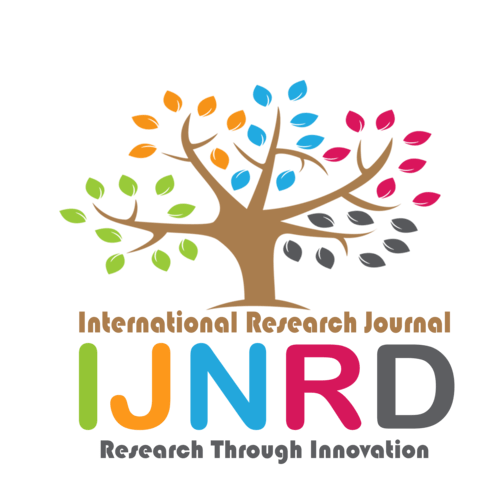|
|||||||||||||||

|
INTERNATIONAL JOURNAL OF NOVEL RESEARCH AND DEVELOPMENT International Peer Reviewed & Refereed Journals, Open Access Journal ISSN Approved Journal No: 2456-4184 | Impact factor: 8.76 | ESTD Year: 2016 Scholarly open access journals, Peer-reviewed, and Refereed Journals, Impact factor 8.76 (Calculate by google scholar and Semantic Scholar | AI-Powered Research Tool) , Multidisciplinary, Monthly, Indexing in all major database & Metadata, Citation Generator, Digital Object Identifier(DOI) |
||||||||||||||
Issue: May 2024
Volume 9 | Issue 5
Review Result and Publication of Paper within : 2-3 days
Click Here For more DetailsFor Authors
Forms / Download
Published Issue Details
Editorial Board
Other IMP Links
Facts & Figure
Impact Factor : 8.76
Issue per Year : 12
Volume Published : 9
Issue Published : 96
Article Submitted :
Article Published :
Total Authors :
Total Reviewer :
Total Countries :
Indexing Partner
Join RMS/Earn 300
Licence
This work is licensed under a Creative Commons Attribution-NonCommercial 4.0 International License







|
Published Paper Details
|
|
| Paper Title: | An Introduction to Ethanobotany, Concept, History Importance and Scope |
| Authors Name: | Dr.Sharad Kumar Singhariya |
| Download E-Certificate: | Download |
| Author Reg. ID: |
IJNRD_207270
|
| Published Paper Id: | IJNRD2310244 |
| Published In: | Volume 8 Issue 10, October-2023 |
| DOI: | |
| Abstract: | Introduction-the term ethanobotany was coined by J.W. Harshberger, an American botanist at the University of Pensylvania, in 1895. Ethanobotany is the systematic study of the relationships between plants and people though initially it was used to describe the study of plants used by primitive and aboriginal people. In other words Ethanobotany means all the sources of the plants towards humankind and the other species growing on the planet. From the ancient time, people have used plants to provide them food, fodder, medicines, clothes, fibers, crafts, dyes, soaps and detergent, dyes, novel compounds, materials for construction. Ethno (as in ethnic) refers to people, culture, a culture collective body of beliefs, knowledge, language and practice. Botany is the study of plants. The scope of Ethanobotany – the scope of this is increasing day by day. To describe the field in broader sense ethnobotanists have given their definitions time to time.Jones (1941) defined Ethnobotany as ‗the study of interrelations of primitive man and plants‘. According to Schultes (1962), Ethnobotany is defined as the study of the relationships which exist between plants and people of a primitive society and their plant environment‘.Vartak and Gadgil (1980) suggested ‗Ethnobotany is a branch of economic botany, a section of which deals with the role of plants in life and culture of aborigines and tribal people‘.Alcom (1984) states that Ethnobotany is the study of contextualized plant use.Jain (1987) applied the term Ethnobotany as the total natural and traditional relationship and interaction between man and his surrounding plant wealth. Wickens (1990) defined Ethnobotany as the study of useful plants prior to their commercial exploitation and eventual domestication.According to ford 1994, Ethanobotany is concerned with a wide range of interest of plants in cultural and ecological context.Turner (1996) has given an appropriate definition that is ―the Science of people‘s interaction with plants‖.Ethanobotany is the use of plants in material or abstract form among ethnic communities or tribal people. Sometimes, it is regarded as ethnographical or anthropological or tribal botany. Ethanobotany is a combination of ethnography and botany. Ethnographers describe the people of a region including their race, language and their uses of plants.Ethanobotany is an interdisciplinary science and undertakes a research on the relationship between plants and humans in the areas of: nutrition, education, archaeology, linguistics, healing, paleology, livelihood, medicine, agriculture etc. The scope of the subject has expanded greatly. Botanists, anthropologists, social scientists, and the practitioners of indigenous medicines are engaged in the study of people-plant interactions in natural environment. History and Concept-The term Ethnobotany was coined by the early 20th century botanist John William Harshberger. The roots of ethnobotanical science can be traced in the ancient Sanskrit, Arabic literatures, Greek, ethnographics, travelogues etc. Vast ethanobotanical knowledge exists in India from ancient time. A variety of uses of plants are mentioned in the ancient Indian Sanskrit literature, e.g. Rigveda, Atharvaveda, Upanishads, Mahabharata and Puranas etc. These include plants used in worships, as medicines, tools of agriculture, food, fuel etc. A list of some of the importance Indian treatises is presented in two vedic periods Rigveda and Athervaveda 148 medicinal plants are included in Charaka Samhita 400-450 medicinal plants are included. Pent-s‘ao, the treatise on herbs written by Emperor Shah Nung has references to 365 drugs. It has also been reported that hundreds of drugs including important species, i.e., henbane, pomegranate, opium, poppy, aloe and onion were commonly used by the Egyptians. Ethanobotany has developed in the recent past into an important scientific discipline. The central issues in the ethnobotanical studies involve the interaction between plants and people and foremost among these are the management of plant diversity by indigenous communities and the traditional use of medicinal plants |
| Keywords: | An Introduction to Ethanobotany, Concept, History Importance and Scope |
| Cite Article: | "An Introduction to Ethanobotany, Concept, History Importance and Scope", International Journal of Novel Research and Development (www.ijnrd.org), ISSN:2456-4184, Vol.8, Issue 10, page no.c391-c397, October-2023, Available :http://www.ijnrd.org/papers/IJNRD2310244.pdf |
| Downloads: | 000118754 |
| ISSN: |
2456-4184 | IMPACT FACTOR: 8.76 Calculated By Google Scholar| ESTD YEAR: 2016 An International Scholarly Open Access Journal, Peer-Reviewed, Refereed Journal Impact Factor 8.76 Calculate by Google Scholar and Semantic Scholar | AI-Powered Research Tool, Multidisciplinary, Monthly, Multilanguage Journal Indexing in All Major Database & Metadata, Citation Generator |
| Publication Details: |
Published Paper ID:IJNRD2310244 Registration ID: 207270 Published In: Volume 8 Issue 10, October-2023 DOI (Digital Object Identifier): Page No: c391-c397 Country: -, -, India Research Area: Engineering Publisher : IJ Publication Published Paper URL : https://www.ijnrd.org/viewpaperforall?paper=IJNRD2310244 Published Paper PDF: https://www.ijnrd.org/papers/IJNRD2310244 |
| Share Article: | |
|
Click Here to Download This Article |
|
| Article Preview | |
|
|
|
Major Indexing from www.ijnrd.org
| Semantic Scholar | Microsaoft Academic | ORCID | Zenodo |
| Google Scholar | ResearcherID Thomson Reuters | Mendeley : reference manager | Academia.edu |
| arXiv.org : cornell university library | Research Gate | CiteSeerX | PUBLON |
| DRJI | SSRN | Scribd | DocStoc |
ISSN Details
 |
 |
ISSN: 2456-4184
Impact Factor: 8.76 and ISSN APPROVED
Journal Starting Year (ESTD) : 2016
DOI (A digital object identifier)
Conference
Open Access License Policy
Important Details
Social Media
| Copyright © 2024 - All Rights Reserved - IJNRD |












Facebook Twitter Instagram LinkedIn